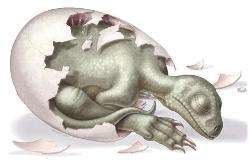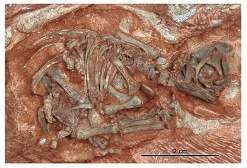Oldest dinosaur embryos give insights into infancy and growth

(PhysOrg.com) -- After sitting in collections for nearly 30 years, some remarkably well-preserved dinosaur eggs and their contents are offering new insights into the infancy and growth of early dinosaurs. They represent the oldest embryos of any land-dwelling vertebrate ever found.
The eggs, found in 1976 in South Africa, date from the early part of the Jurassic Period, 190 million years ago. They belong to Massospondylus (măs-ō-spŏn-dīl-ŭs), a member of a group of dinosaurs known as prosauropods that are the ancestors to the later sauropods – the large, four-legged dinosaurs with long necks, typified by the popular ‘Brontosaurus’ and Diplodocus.
Dr. Robert Reisz of the University of Toronto and his colleagues worked on these fossils, and it was only through modern preparation techniques that these findings were brought to light. One of Dr. Reisz’s co-authors, research assistant Diane Scott, prepared the delicate fossils under high-powered microscopes and compiled the illustrations. “I don’t think anybody else could have done this job,” says Dr. Reisz.

These eggs contain the oldest known embryos of dinosaurs. In fact, they are the oldest of any land-dwelling backboned animal. The preservation of the embryos is exquisite, permitting a complete reconstruction of the skeleton and detailed interpretations of the anatomy.
The level of ossification – how much of the skeleton has turned to bone – reveals that the embryos were close to hatching. The fossils also reveal that the future hatchlings would have been oddly proportioned and would have looked very different from the adults of the species.
The 20 cm (8 in.) embryos were quadrupedal (they walked on all four legs), with relatively long front limbs and disproportionately large heads. In contrast, the 5 m (16.5 ft) long adults had relatively tiny heads and long necks; they mostly likely were bipedal, given that their forelimbs are much shorter than their hind limbs. This implies that as the dinosaurs matured, their necks and hind limbs grew much faster than their forelimbs and head. Later dinosaurs in this group, the sauropods, had body proportions more similar to those of the Massospondylus embryos.
In at least one way, Massospondylus development resembles that of humans; infancy is awkward, and a more erect stance and evenly proportioned body only come later.
There may be another way that Massospondylus infancy was similar to that of humans. The embryos lack teeth and this, combined with the awkward body proportions, suggests that the hatchlings may have required parental care. If true, these fossils also document the oldest record of parental care.

“This project opens an exciting window into the early history and evolution of dinosaurs,” says Reisz. “Prosauropods are the first dinosaurs to diversify extensively, and they quickly became the most widely spread group, so their biology is particularly interesting as they represent in many ways the dawn of the age of dinosaurs.”
The eggs and embryos are on display at the Royal Ontario Museum in an exhibit entitled, “Dinosaur Eggs and Babies: Remarkable Fossils from South Africa.” Dr. David Evans, one of the co-authors of this research, is curator at that museum.
More information: Reisz, R.R., D.C. Evans, H.-D. Sues, D. Scott. 2010. Embryonic skeletal anatomy of the sauropodomorph dinosaur Massospondylus from the Lower Jurassic of South Africa. Journal of Vertebrate Paleontology 30(6). PDF pre-print: www.vertpaleo.org/userfiles/File/JVP%20preprint.pdf
Provided by Society of Vertebrate Paleontology











.jpg)







